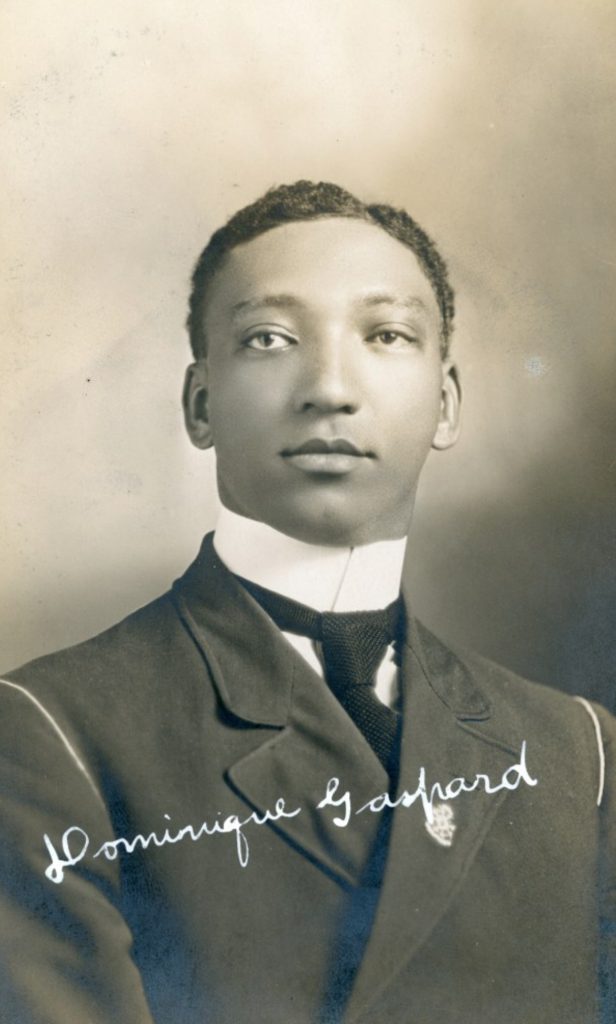Not Just Numbers
Case 9 Conclusion: Dr. Dominique Gaspard
Fifteen Minutes

Did you find anything surprising about this person’s life?
Did you make any assumptions that were later challenged?
Is there anything specific about this person that you would like to know?
Details
Dr. Dominique Gaspard was born in New Orleans, Louisiana, to an Afro-French Creole family on December 22nd, 1884. He, along with his twin brother Bathelmi, mother Esther, and father John, lived in the St. Katherine’s parish, where free people of colour could hold positions of privilege. Over the next 20 years, many residents of St. Katherine’s parish converted to Catholicism.
In 1905, Dominique left New Orleans for Canada, to study at the Séminaire de Saint-Hyacinthe, in Quebec. This seminary enrolled students of African ancestry since as early as the 1860s, and is located roughly 60 kilometres east of Montréal. Dominique recounted his experience at the college in an article published in the school’s journal in 1910. He graduated in 1911, planning on joining the Dominican Order, but by 1912 he had begun medical school at Université Laval in Montréal.
Dominique paused his medical training during WWI to enlist in the Canadian Army Medical Crops in 1915. He served in Saint-Cloud, a Paris suburb, with No. 4 Stationary Hospital, which became No. 8 General Hospital in 1916. They converted a former race track into a medical facility, building wooden huts and naming them after Canadian cities and locations. Dominique was quickly promoted to corporal, then to sergeant, and was awarded La Médaille des épidémies du ministère de la Guerre in April 1917. In September of 1917, Dominique returned to Université Laval. He completed his medical training in spring of 1918, opening a practice in Montréal that same year.
By 1920, Dominique had become an active member of the community, joining the Union United Church, and the local division of the Universal Negro Improvement Association. In 1921, he married Ethel May Lyons, a member of his congregation at Union United. Ethel and Dominique would go on to found the Negro Community Centre of Montréal in 1927, and then the Coloured War Veterans’ Legion (Québec no. 50) in 1935. After a short illness, Dominque died on February 6, 1938.
In 1953, the Coloured War Veterans’ Legion (Québec no. 50 was renamed the Dr. Gaspard Royal Canadian Legion Branch No. 50.
Dominique was designated as a national historic person by the Government of Canada in 2024.
For more information:
Litalien, Michel. “Dominique Gaspard.” L’ALBUM DE LA GRANDE GUERRE. n.d. https://albumgrandeguerre.ca/Album-Grande-Guerre/La-Grande-Guerre/Medecine/Dominique-Gaspard.
Parks Canada Agency, Government of Canada. “Dominique François Gaspard (1884–1938) National Historic Person.” Parks Canada Agency, Government of Canada, November 20, 2024. https://parks.canada.ca/culture/designation/personnage-person/dominique-francois-gaspard.
Williams, Dorothy. A Posthumous Honour for a Conspicuous Life: Dr. Gaspard in Quebec, 2020. https://www.concordia.ca/content/dam/artsci/scpa/quescren/docs/Williams_Paper_final.pdf.
Williams, Dorothy W, and William Ma. “Dominique Gaspard | the Canadian Encyclopedia.” The Canadian Encyclopedia, November 22, 2024. https://www.thecanadianencyclopedia.ca/en/article/dominique-gaspard.
